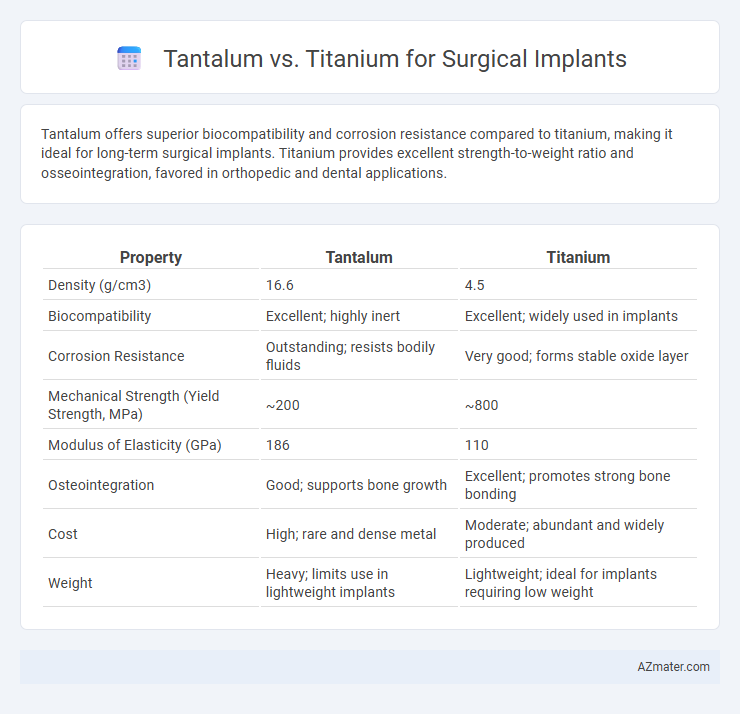Tantalum offers superior biocompatibility and corrosion resistance compared to titanium, making it ideal for long-term surgical implants. Titanium provides excellent strength-to-weight ratio and osseointegration, favored in orthopedic and dental applications.
Table of Comparison
| Property | Tantalum | Titanium |
|---|---|---|
| Density (g/cm3) | 16.6 | 4.5 |
| Biocompatibility | Excellent; highly inert | Excellent; widely used in implants |
| Corrosion Resistance | Outstanding; resists bodily fluids | Very good; forms stable oxide layer |
| Mechanical Strength (Yield Strength, MPa) | ~200 | ~800 |
| Modulus of Elasticity (GPa) | 186 | 110 |
| Osteointegration | Good; supports bone growth | Excellent; promotes strong bone bonding |
| Cost | High; rare and dense metal | Moderate; abundant and widely produced |
| Weight | Heavy; limits use in lightweight implants | Lightweight; ideal for implants requiring low weight |
Introduction to Tantalum and Titanium in Surgical Implants
Tantalum and titanium are biocompatible metals widely used in surgical implants due to their exceptional corrosion resistance and mechanical strength. Tantalum offers superior osteointegration and radiopacity, making it ideal for bone grafting and reconstructive procedures. Titanium exhibits a high strength-to-weight ratio and excellent biocompatibility, commonly applied in orthopedic, dental, and cardiovascular implants.
Biocompatibility: Tantalum vs Titanium
Tantalum exhibits superior biocompatibility compared to titanium due to its excellent corrosion resistance and minimal inflammatory response in the human body. Titanium also offers good biocompatibility but may cause mild immune reactions in some patients due to ion release over time. Studies show tantalum's porous structure promotes better osseointegration, enhancing long-term stability for surgical implants.
Mechanical Properties and Strength Comparison
Tantalum exhibits superior corrosion resistance and biocompatibility, making it ideal for long-term surgical implants, while titanium offers a higher strength-to-weight ratio and excellent fatigue resistance. Mechanically, tantalum has a lower tensile strength (approximately 173 MPa) compared to titanium alloys, which can exceed 900 MPa, enhancing the structural integrity of load-bearing implants. Titanium's modulus of elasticity (around 110 GPa) closely matches that of bone, reducing stress shielding, whereas tantalum's higher modulus (approximately 186 GPa) provides enhanced stability but may increase stress concentration around the implant site.
Corrosion Resistance in Biological Environments
Tantalum exhibits superior corrosion resistance in biological environments compared to titanium due to its stable oxide layer that prevents ion release and degradation. Titanium, while biocompatible and widely used, can undergo localized corrosion such as pitting in aggressive physiological conditions. The enhanced corrosion resistance of tantalum makes it ideal for long-term surgical implants where material stability and biocompatibility are critical.
Osseointegration and Bone Attachment
Tantalum exhibits superior osseointegration compared to titanium due to its high porosity and biocompatibility, which promote enhanced bone ingrowth and stable implant fixation. Titanium offers excellent strength and corrosion resistance but relies on surface treatments to improve bone attachment, whereas tantalum's trabecular structure mimics natural bone, facilitating faster and more robust integration. Clinical studies show tantalum implants achieve higher bone-to-implant contact rates, making them preferable for procedures requiring rapid and durable bone attachment.
Imaging Compatibility: MRI and Radiopacity
Tantalum exhibits excellent MRI compatibility due to its non-ferromagnetic properties, minimizing artifacts and ensuring clear imaging during postoperative evaluations compared to titanium, which may cause mild distortions. In radiopacity, tantalum's higher density makes it more visible on X-rays, aiding precise implant localization, whereas titanium's lower radiopacity can complicate image interpretation. These imaging characteristics make tantalum favorable for surgical implants requiring superior MRI clarity and radiographic visibility.
Allergic Reactions and Hypersensitivity Risks
Tantalum exhibits superior biocompatibility with a notably low incidence of allergic reactions, making it suitable for patients with metal sensitivities. Titanium is widely used in surgical implants due to its strength and corrosion resistance, but rare cases of hypersensitivity and allergic responses have been reported, particularly in individuals with pre-existing metal allergies. Clinical studies highlight tantalum's inert properties as advantageous in minimizing immune response compared to titanium alloys, which may release ions that trigger hypersensitivity in susceptible patients.
Longevity and Implant Failure Rates
Tantalum exhibits exceptional biocompatibility and corrosion resistance, contributing to superior longevity in surgical implants compared to titanium. Studies indicate lower implant failure rates for tantalum due to its porous structure that promotes osseointegration and mechanical stability. Titanium, although widely used for its strength and lightness, experiences higher failure rates related to fatigue and wear over extended periods.
Cost Analysis and Availability
Tantalum implants exhibit higher material and manufacturing costs due to their rarity and complex processing, making them less cost-effective compared to titanium, which is abundant and widely available. Titanium's favorable price-performance ratio stems from its extensive global supply chain and well-established fabrication technologies, driving down overall implant expenses. Cost-conscious healthcare providers often prefer titanium implants for their affordability without compromising biocompatibility and mechanical strength.
Choosing the Right Material: Clinical Recommendations
Tantalum offers superior biocompatibility and osteointegration, making it ideal for load-bearing surgical implants in patients with metal sensitivities or compromised bone quality. Titanium provides excellent strength-to-weight ratio and corrosion resistance, favored for cardiovascular and orthopedic implants requiring long-term durability. Clinical recommendations prioritize tantalum for high-risk revision surgeries and titanium for primary implantation due to cost-effectiveness and well-documented safety profiles.

Infographic: Tantalum vs Titanium for Surgical Implant
 azmater.com
azmater.com